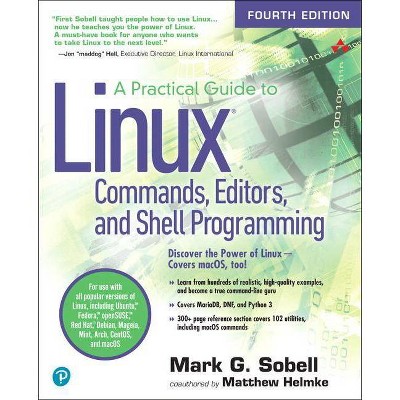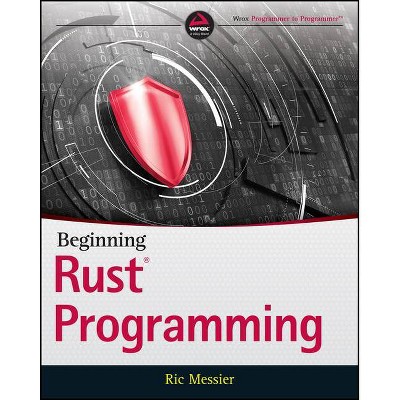Beginning Linux Programming - 4th Edition by Neil Matthew & Richard Stones (Paperback)

Similar Products
Products of same category from the store
AllProduct info
<p/><br></br><p><b> Book Synopsis </b></p></br></br><b>Beginning Linux Programming, </b> Fourth Edition continues its unique approach to teaching UNIX programming in a simple and structured way on the Linux platform. Through the use of detailed and realistic examples, students learn by doing, and are able to move from being a Linux beginner to creating custom applications in Linux. The book introduces fundamental concepts beginning with the basics of writing Unix programs in C, and including material on basic system calls, file I/O, interprocess communication (for getting programs to work together), and shell programming. Parallel to this, the book introduces the toolkits and libraries for working with user interfaces, from simpler terminal mode applications to X and GTK+ for graphical user interfaces. Advanced topics are covered in detail such as processes, pipes, semaphores, socket programming, using MySQL, writing applications for the GNOME or the KDE desktop, writing device drivers, POSIX Threads, and kernel programming for the latest Linux Kernel.<p/><br></br><p><b> From the Back Cover </b></p></br></br><p><b>Beginning Linux<sup>(R)</sup> Programming 4th Edition</b> <p>Building on the success of its previous editions, this must-have guide continues its popular tutorial approach and brings you a straightforward introduction to developing programs for Linux and other UNIX-style operating systems. The author duo of experienced Linux programmers covers a wide range of topics to help you learn more about what Linux has to offer so you can maximize your programming time and your use of the Linux system. <p>You'll progress from the basics of compiling programs, linking to libraries, and dealing with terminal input and output to more advanced subjects such as writing applications for the GNOME<sup>(R)</sup> and KDE<sup>(R)</sup> environments, storing data using MySQL<sup>(R)</sup>, and debugging. As each topic is covered, the authors introduce an appropriate programming theory and then illustrate it with practical examples, clear explanations, and a step-by-step approach with the intent that you will learn by doing. You'll quickly evolve from being a Linux beginner to confidently creating custom applications in Linux. <p><b>What you will learn from this book</b> <ul> <li>How to use the standard Linux C libraries and other facilities</li> <li>Ways to make the most of the standard Linux development tools</li> <li>Tips on basic system calls, file I/O, interprocess communication, and shell programming </li> <li>How to build graphical user interfaces using the GTK+ or Qt toolkits</li> <li>Using sockets to support TCP/IP networking to different machines</li> <li>How to write programs that will work on different distributions of Linux</li> </ul> <p><b>Who this book is for</b> <p>This book is for programmers and developers who want to increase their skill level using Linux. Experience in C and/or C+ + programming is helpful. <p>Wrox Beginning guides are crafted to make learning programming languages and technologies easier than you think, providing a structured, tutorial format that will guide you through all the techniques involved.<p/><br></br><p><b> About the Author </b></p></br></br><b>Neil Matthew</b> has been interested in and has programmed computers since 1974. A mathematics graduate from the University of Nottingham, Neil is just plain keen on programming languages and likes to explore new ways of solving computing problems. He's written systems to program in BCPL, FP (Functional Programming), Lisp, Prolog, and a structured BASIC. He even wrote a 6502 microprocessor emulator to run BBC microcomputer programs on UNIX systems. In terms of UNIX experience, Neil has used almost every flavor since the late 1970s, including BSD UNIX, AT&T System V, Sun Solaris, IBM AIX, many others, and of course Linux. He can claim to have been using Linux since August 1993 when he acquired a floppy disk distribution of Soft Landing (SLS) from Canada, with kernel version 0.99.11. He's used Linux-based computers for hacking C, C++, Icon, Prolog, Tcl, and Java at home and at work.<br />All of Neil's home projects are developed using Linux. He says Linux is much easier because it supports quite a lot of features from other systems, so that both BSD- and System V-targeted programs will generally compile with little or no change.<br />Neil is currently working as an Enterprise Architect specializing in IT strategy at Celesio AG. He has a background in technical consultancy, software development techniques, and quality assurance. Neil has also programmed in C and C++ for real-time embedded systems. <p><b>Rick Stones</b> started programming at school (more years ago than he cares to remember) on a 6502-powered BBC micro, which, with the help of a few spare parts, continued to function for the next 15 years. He graduated from Nottingham University with a degree in Electronic Engineering, but decided software was more fun.<br />Over the years he has worked for a variety of companies, from the very small with just a dozen employees, to the very large, including the IT services giant EDS. Along the way he has worked on a range of projects, from real-time communications to accounting systems, to very large help desk systems. He is currently working as an IT architect, acting as a technical authority on various major projects for a large pan-European company.<br />A bit of a programming linguist, he has programmed in various assemblers, a rather neat proprietary telecommunications language called SL-1, some FORTRAN, Pascal, Perl, SQL, and smidgeons of Python and C++, as well as C. (Under duress he even admits that he was once reasonably proficient in Visual Basic, but tries not to advertise this aberration.)</p>
Price History
Price Archive shows prices from various stores, lets you see history and find the cheapest. There is no actual sale on the website. For all support, inquiry and suggestion messagescommunication@pricearchive.us




















